Adaptive Riders
Join the community at the world’s largest mountain biking festival.
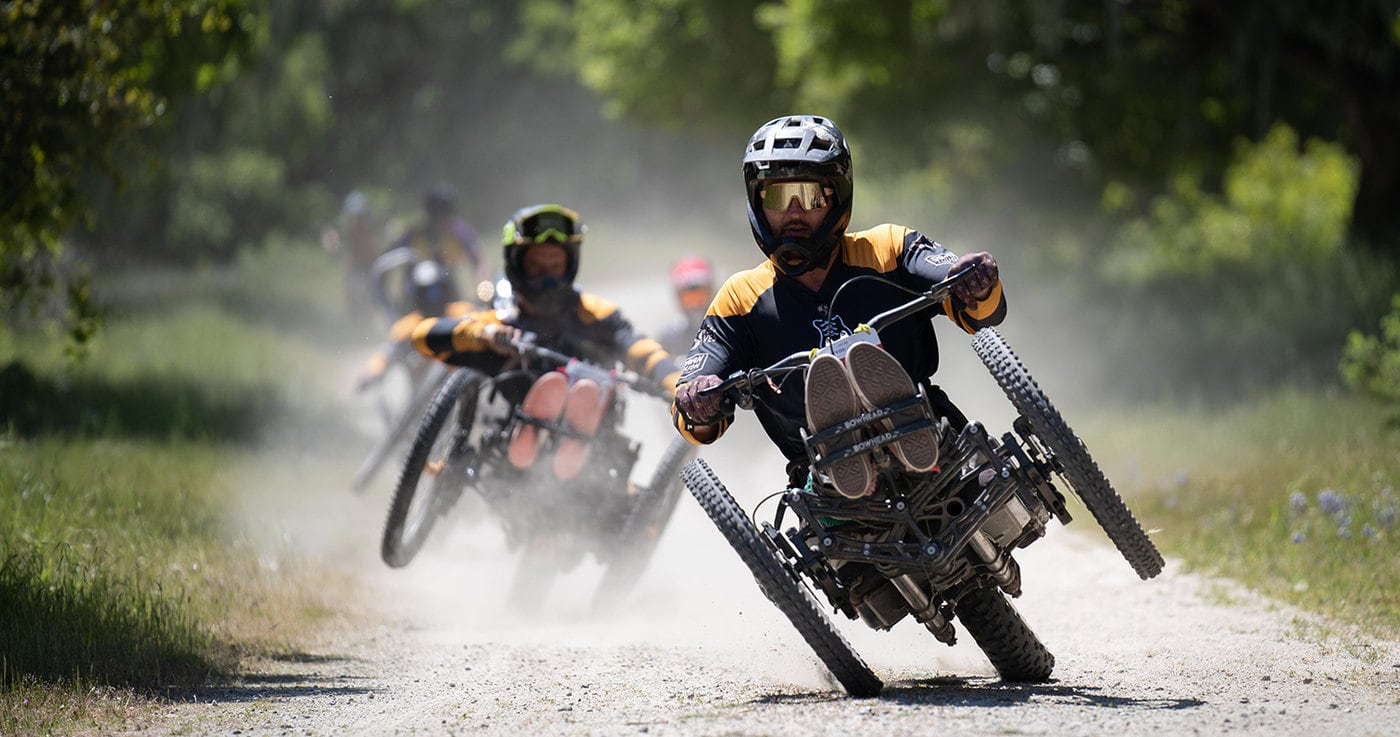
Photo by Joe Stone
Seth McBride, New Mobility July 1 2023
I started adaptive mountain biking seven years ago. At the time, I was riding a traditional recumbent handcycle with no motor — it was better than nothing, but still a poor approximation of the nondisabled experience. How quickly times change. Today, adaptive mountain bikes can take you places that a traditional handcycle never could, and the sport is quickly being integrated into the broader mountain biking community.
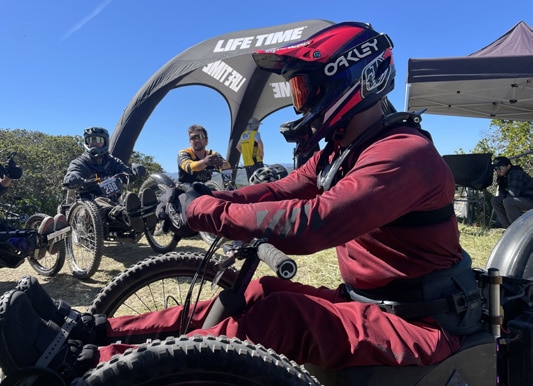
Photo by Seth McBride
In April, I went down to the world’s largest mountain biking festival, the Sea Otter Classic, in Monterey, California, to see what this integration felt like and what was driving it. There are many reasons for the sport’s advancement — but they boil down to the bikes and the riders. All the adaptive sit-down riders at this year’s event were riding Bowhead bikes, which have a unique, articulating front end that allows you to ride dirt at speeds that no other adaptive mountain bike will let you.
The bike was designed by wheelchair user Christian Bagg and has unleashed a host of mountain sport athletes — many of whom participated in or were injured in adrenalin-fueled activities — to keep charging hard after SCI. They’re surprisingly quad-friendly too — fully adaptable for low-quads, with some power chair users finding ways to ride them as well.

Photo by Joe Stone
As a company, Bowhead has been working to integrate its brand and adaptive riders, into the scene since it first attended Sea Otter in 2019. They’ve succeeded. A big part is the people running the event just seem to get it: Disabled or nondisabled, people just want to have fun riding bikes. As Sarah Timlick, the expo sales director for Sea Otter, puts it, “It really is just this massive, joyful festival that celebrates everything bicycle and cycling related.”
At Sea Otter, adaptive divisions were incorporated into the racing schedule, using the same courses as everyone else. There was plenty of accessible parking and a number of accessible porta-potties. Adaptive riders had our own tent area to leave wheelchairs and any other gear when we were out riding. We had our own space, but it never felt apart — we were right in the middle of it all.
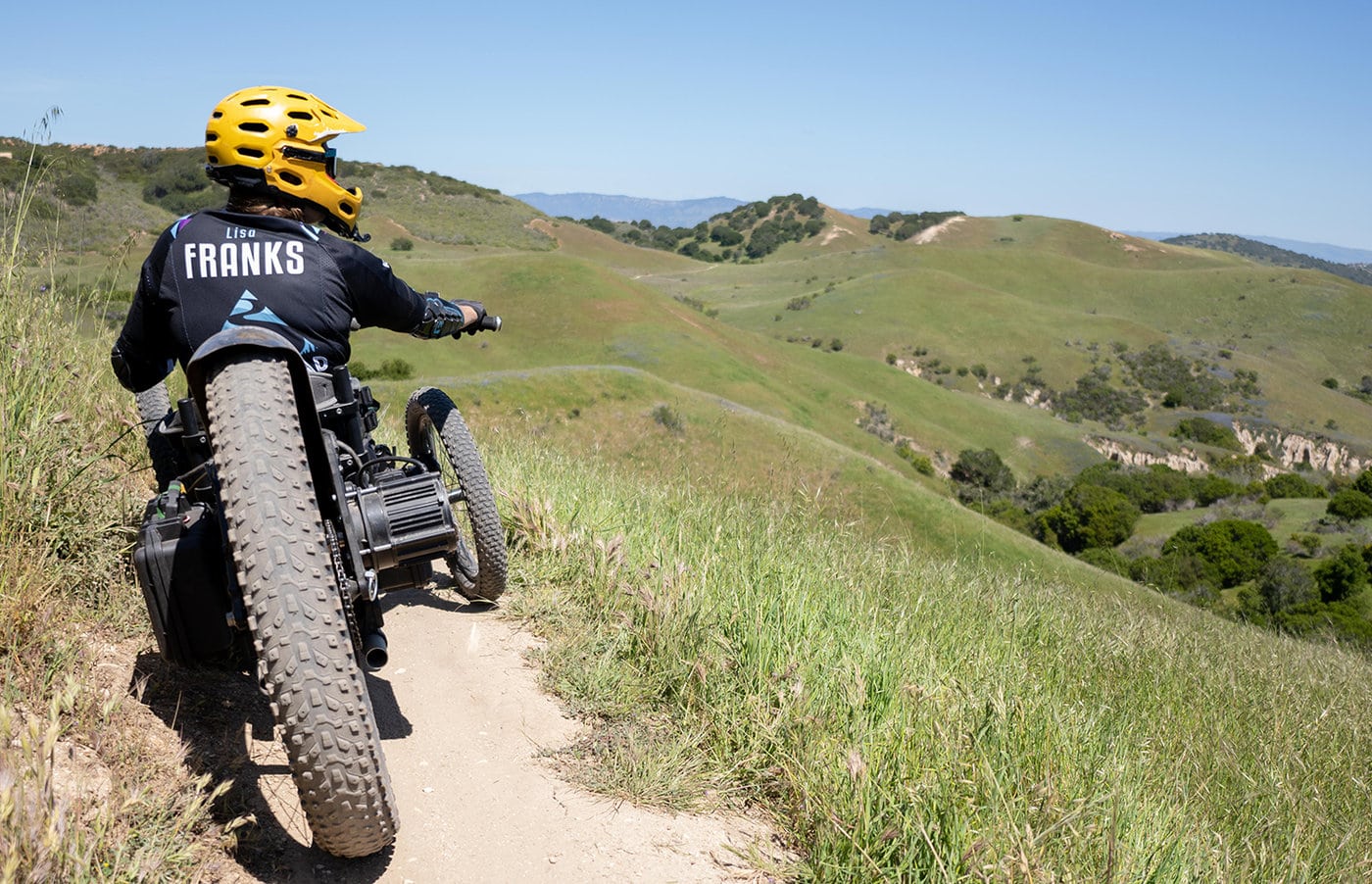
Racing is fun, but most of what draws people to adaptive mountain biking is the chance to be active outside, exploring beautiful areas that they wouldn’t be able to otherwise. Here, Lisa Franks checks out the rolling hills — still green in early April — that surround Monterey, California. Photo by Joe Stone

Photo by Seth McBride
Another driving force behind the visibility of adaptive mountain biking in the broader mountain biking world is Martyn Ashton (right), seen here discussing the downhill course with Pierre Bergman. Ashton is a para and former world champion in trials — which consists of jumping mountain bikes up, over and off all sorts of obstacles. He’s now a presenter on Global Mountain Bike Network, the world’s largest mountain bike channel, which has 1.9 million subscribers on YouTube. Ashton is on GBMN all the time, sometimes talking about standup mountain bikes, sometimes talking about and riding adaptive mountain bikes. He’s got an easy-going, self-deprecating style, which quickly dispenses with any “isn’t it nice that the wheelchair guy can ride a bike,” vibes. Ashton makes adaptive mountain biking look fun and normal, and millions of people get to see it.
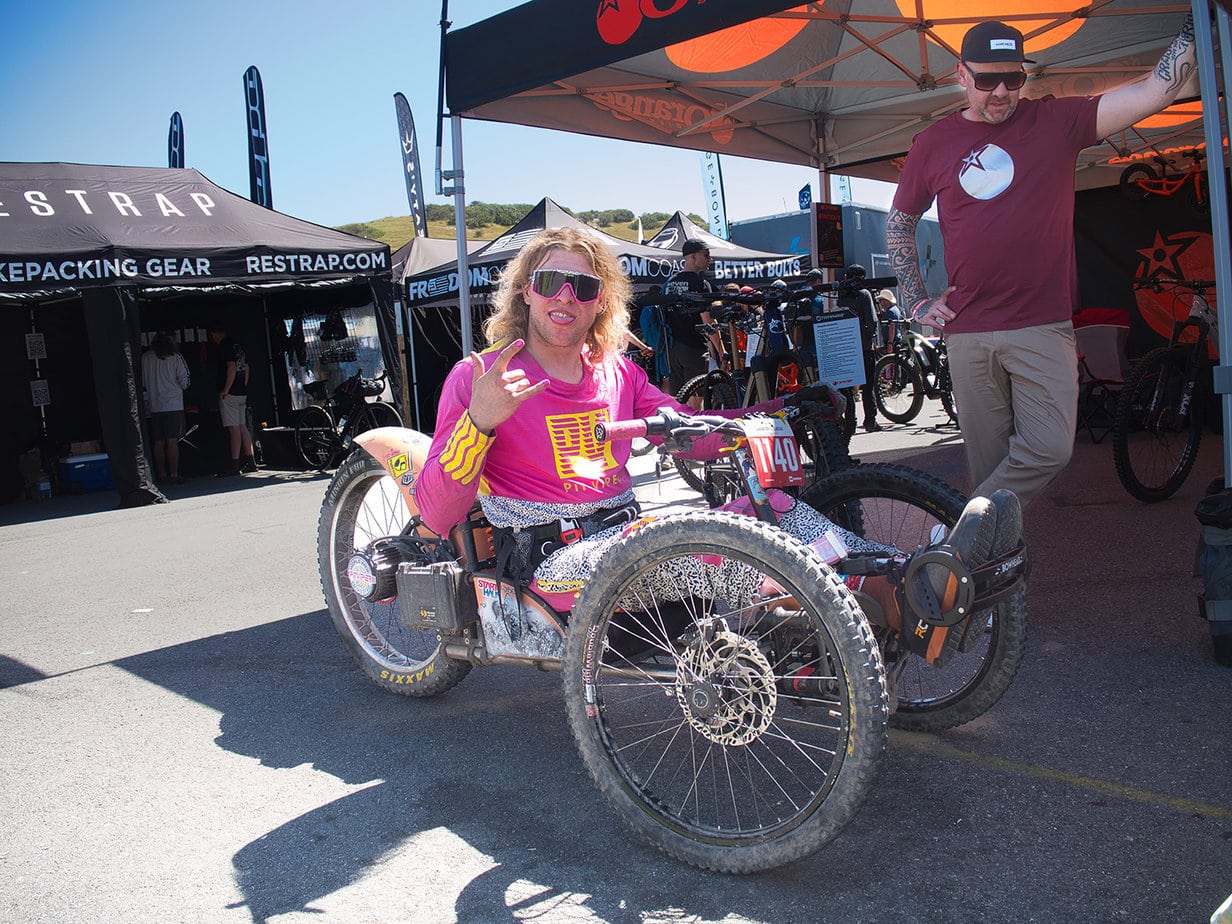
Photo by Seth McBride
Wufke Crosby is the kind of guy who will drink Champagne out of his shoe to celebrate a third-place finish. I guess it’s not as gross since his feet don’t sweat. Or maybe it is. Either way, Crosby likes to go fast. Sometimes this goes well. Like last year when he won both the downhill and the dual slalom at Sea Otter. Sometimes it doesn’t. This year he charged full throttle into a section of muddy ruts at the bottom of the downhill course, rode his left wheel up a chain link fence and flipped on his head. Don’t worry, Crosby was fine — and still stoked on the weekend.

Photo by Joe Stone
The Sea Otter Classic is the largest mountain biking festival in the world. It spans four days —10,000 racers, 74,000 fans and around 750 brands that set up booths in the expo center. There are professional races. There are amateur races. There are children riding bikes, people riding unicycles, adults riding tiny bikes or jumping electric unicycles. There are many, many people on e-bikes. Increasingly, there are wheelchair users — nearly 20 attended this year, the biggest field ever. Most of us are here to race, but just being here is important. The Sea Otter Classic is where everybody who’s anybody in the mountain biking world comes to see and be seen. “When we first started coming here, we were the weird little guys, and the only people who came to our tent were the other weird people,” says Christian Bagg, the founder of Bowhead. “ But now we’re not the weird little guys anymore.”
Over the course of my 20-plus years as a wheelchair user, I’ve met a lot of impressive quads but none who live closer to my ideal than the ones I met at Sea Otter. Lisa Franks is a Canadian multiple Paralympic gold medalist in wheelchair racing. She made a good living as a mechanical engineer, until corporate downsizing took her job. Now she lives on public speaking gigs and spends her winters wandering around California in her van — surfing, riding her Bowhead, catching up with friends and doing it all independently. She raised her bed so she can fit her bike underneath and she gets to “cuddle with my surfboard every night.” Sounds like the good life to me. Get a full tour of her van:
| Camper Van Build w/ Wheelchair Lift for Paralympic Olympic Athlete. Tiny Home Tours. Youtube Jul 29, 2022 |
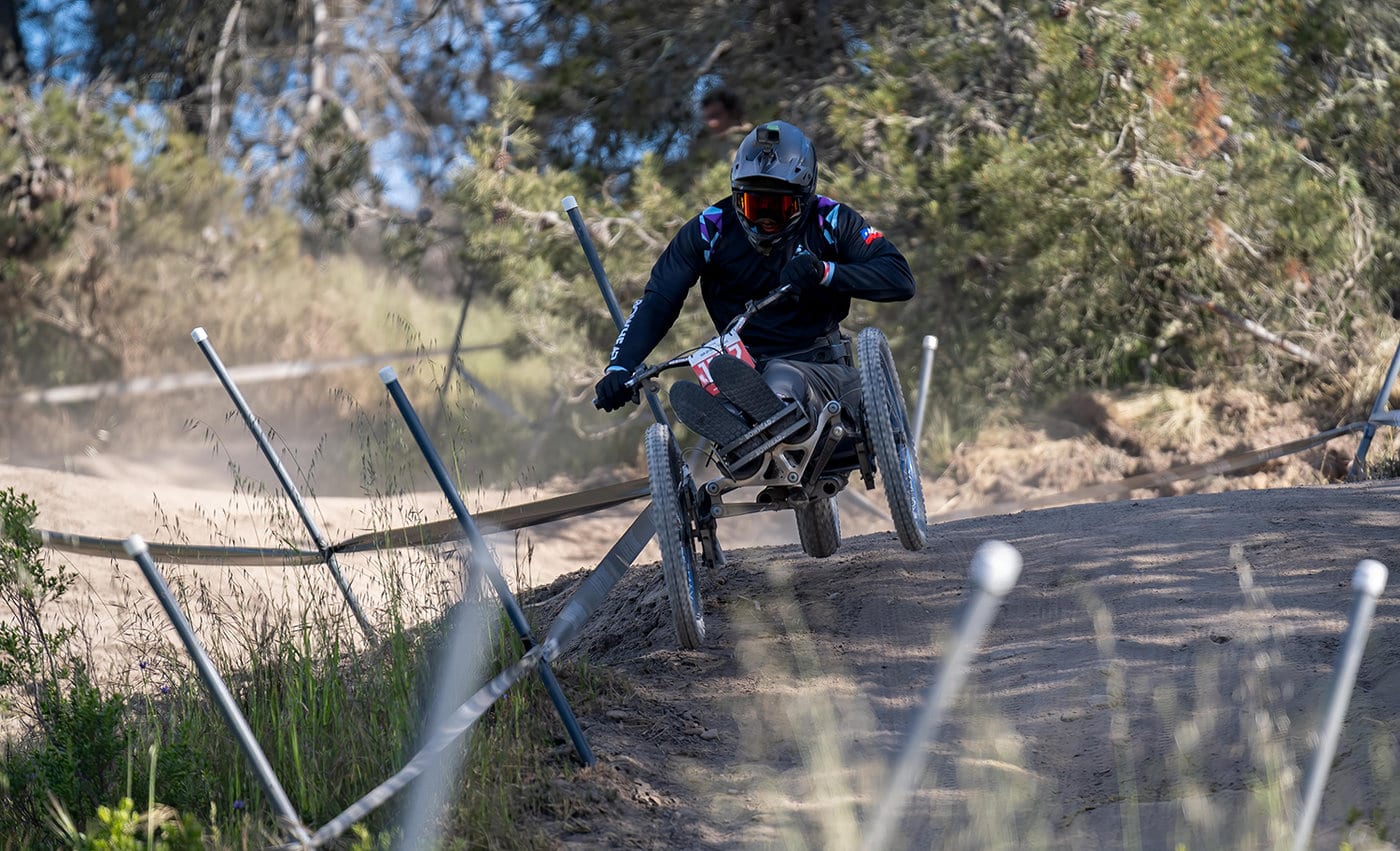
Photo by Joe Stone
Gustavo Ortiz, a Chilean former mountain bike World Cup downhill racer, won the adaptive downhill at Sea Otter. Ortiz is fast and smooth and makes things that are very hard look easy. Ortiz got second in the adaptive dual slalom race, and during practice laps he was beating nondisabled racers down the course. Top riders like Ortiz and former motocross racer Cole Bernier (who won the dual slalom) are pushing the boundaries of the sport every time they get on their bikes.
![]() Source New Mobility
Source New Mobility
